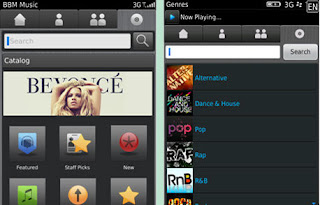
BBM Music offers easy to use RIM's cloud service that enables viral music discovery through social interactions by allowing it users to build community-based music library that is shared among user's BBM Music friends. The size of the music library stated to continues to grow as new friends join the community and each user can select musics from a catalog with millions of songs from legal music companies (Universal Music Group, Sony Music Entertainment, Warner Music Group and EMI).

RIM was makes the tagline for BBM Music app for Blackberry as; more friends = more music.
Once a user have created a BBM Music sharing friendship with any BBM contacts, he/she can make use of all that BBM Music has to offer, just like other BBM-connected apps. BBM Music app was built using the same BBM SDK (Software Development Kits) that is extended to the Blackberry developer community.

But, the BBM Music services that paid US$ 4.9 per month should work hard to earn interest at music streaming market. Because BBM Music users will be limited only to select 50 songs from millions of songs that exist in the RIM catalog.
So, this BBM enhancement service is still widely criticized, mainly because of restrictions on 50 songs to choose from. This service is like intended to drive users to invite random people through the BBM (Blackberry Messenger), so they can get more songs. But users may prefer to consider the social aspects of the app, rather than just collecting friends to get more songs.
BBM Music has been designed to allow user to:
1) Build a music profile from a catalog of millions of tracks,
2) Invite friends to BBM Music and gain access to their musics,
and also share own musics (requires subscription),
3) Create playlists from BBM Music songs and friend's musics,
4) Share playlists or single songs with BBM Music's friends,
5) Follow friend's BBM Music activity with timelines and comments,
6) Start up a BBM chat about favorite bands,
7) Cache musics for offline listening,
8) Seamless integration with other BlackBerry music services.
9) Topping the charts; keep track of how many listeners to own tracks.





0 comments:
Post a Comment